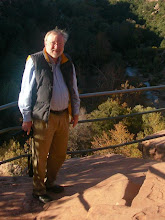I just returned from a lengthy, but brief, road trip. My wife and I drove 1700 miles spread out over only 3 days. 850 Dallas to Knoxville on Friday, and 850 Knoxville to Dallas on Sunday. On a good day with sunshine and light traffic, 850 miles is about my driving limit. On a bad day, with heavy traffic and heavy rain, it's just too far.
The Sunday trip was a fiasco of bad alternatives. About 6 hours of the 14 hour trip were in heavy rain. Visibility was down to about 200 yards, and the road between Memphis and Texarkana was loaded with traffic. Interstate 40 between Memphis and Little Rock is always heavy 18 wheeler traffic, and dealing with it in the rain is espescially stressful.
The alternatives are drive the speed limit and go with the flow, even in poor visibility; slow down and risk being run over or contributing to a traffic problem; or just get off the road or find another route. I chose go with the flow, even though the visibility was extremely poor, probably bad judgement and high risk. This brings me to the point of this post:
Driving our interstate highways can be a high risk activity!Here are some of the frustrations:
Speed Limits and Speed enforcement vary from state to state.Different speed limits in different states are certainly understandable. Miles of open road I-90 in Montana or I-80 in Wyoming certainly justify higher speeds than I-95 in New England. What's more difficult to understand is the wide variations in enforcement. Why isn't a speed limit a speed limit? It's a guessing game to figure out what the magic number is. As a law abiding citizen, I drive at the speed limit on the open road. In some cases, this is more hazardous than going with the flow.
On the otherhand, I passed no less than 10 radar checks in Tennessee enroute between Knoxville and Memphis. The speed limit was generally 70, and much of the traffic was flowing at about 75. What speed was too much? Who knows?
There is way to much speed variations among vehicles on the roadNo matter how fast you drive, someone will go faster. No matter how slow you go, someone will go slower. Extremes in either direction created hazardous and frustrating situations.
The dangers of average speedIn hilly or mountainous country, trucks especially seem to practice the concept of average speed. What this means is in a stretch of road with a speed limit of 65, you may find trucks slowing to 45 going uphill and accelerating to 85 going downhill. It is so frustrating to get behind trucks going uphill, trying to pass each other, with one going 45 mph and the other going 46. If you are able to get by this problem, you are promptly blown away by both of them going downhill at 80 a few minutes later.
The lower the speed limit, the greater the violationsAs I said before, I usually drive the speed limit. Last summer, driving through West Texas where the speed limit was 75, I drove 75. Almost no one passed me, and I passed very few myself. It seems most people just don't want to go faster than about 75.
Friday, as I approached Knoxville, in East Tennessee, the speed limit steadily is reduced from 70, to 65, and then to 55 as you near the city. At 70, the ration of cars passing me to cars I was passing was about 50/50. At 65, it was probably about 60/40, and at 55, it was about 90/10. This is frustration at it's extreme. Why adopt a speed limit you have no intent to enforce?
Size MattersTrucks are way bigger than cars, all cars. All cars lose when they hit trucks. But! as we trend toward smaller cars, the matter gets worse. My wife and I used to own a Mercedes SLK. This is a really small car. On several occasions we were nearly pushed off the road by an 18 Wheeler whose driver simply didn't see us.
Self imposed solutionsI can't fix this problem. Maybe, over time, our efforts to reduce our oil dependence and switch to alternative fuels will also bring changes to our transportation infrastructure which may address some of these problems. Meanwhile, I'm going to impose some changes on myself to try and lower both stress and risk when I travel.
As a retired citizen, time is not as important as it used to be. So, for starters, I am going to try and avoid the very busiest of the Interstate Highways, and enjoy more of the countryside. I get way better gas milage in my SUV at 60 than I do at 70 anyway, so slowing down and taking the less traveled byways may be both more scenic and less stressful.
